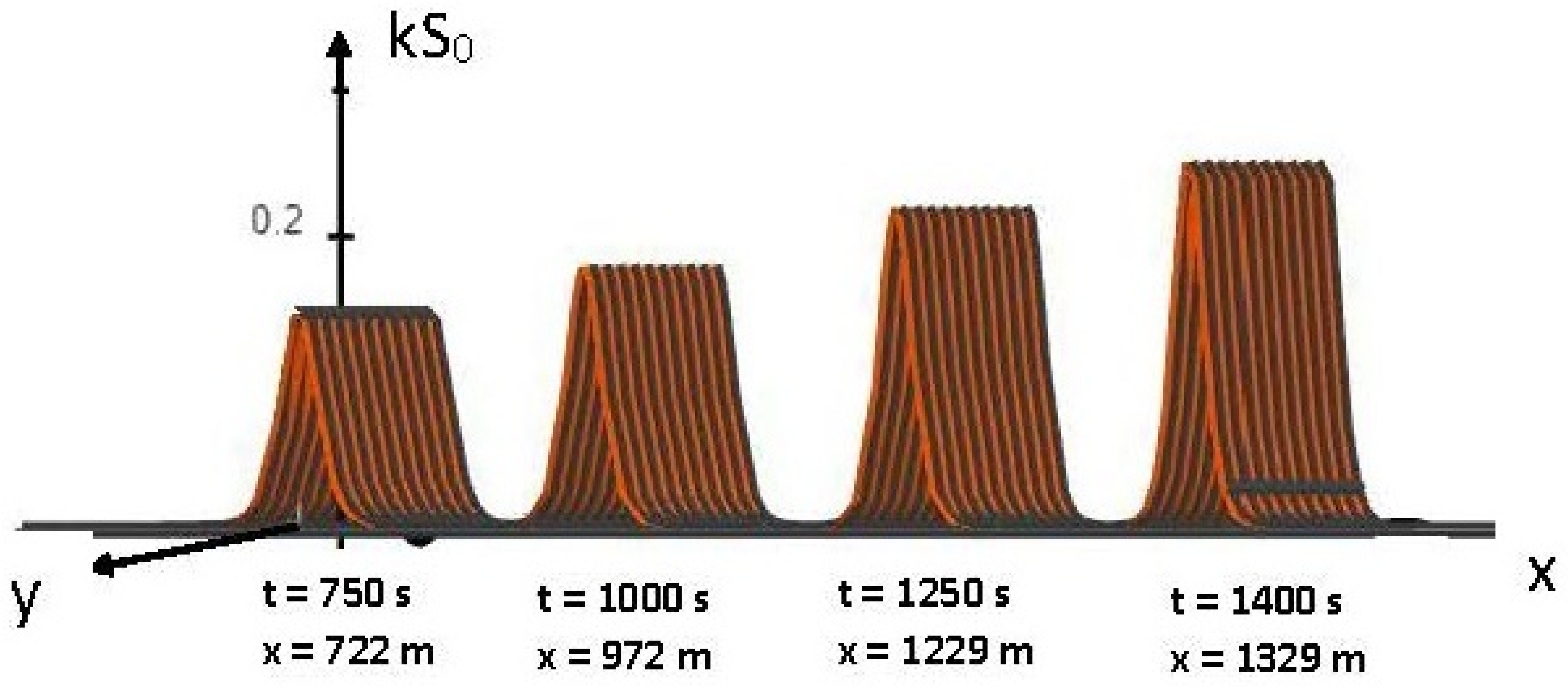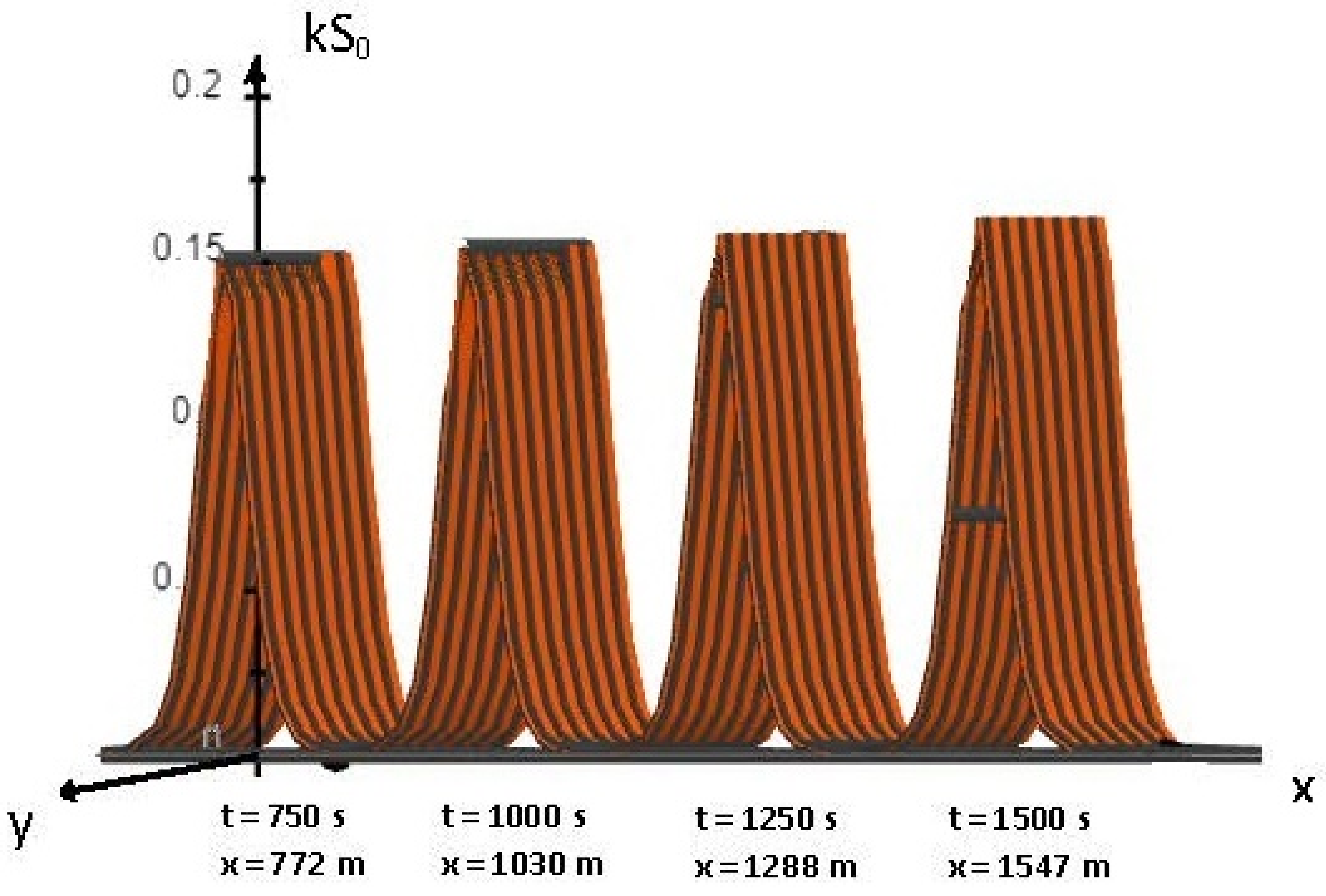Serre-Green-Naghdi Dynamics under the Action of the Jeffreys’ Wind-Wave Interaction
Abstract
:1. Introduction
2. Materials and Methods
2.1. The Water Domain in the Nonlinear Serre-Green-Naghdi Approximation
2.2. Jeffreys’ Sheltering Mechanism of Wind Waves Generation Applied to Serre-Green-Nagdhi Equations
2.3. Application of Green’s Theorem in One Dimension
2.4. Blow-Up in Finite Time of the Serre-Green-Naghdi Soliton Solution
3. Results
3.1. For a Depth of 0.14 m
3.2. For a Depth of 0.26 m
4. Conclusions
Author Contributions
Funding
Institutional Review Board Statement
Informed Consent Statement
Data Availability Statement
Conflicts of Interest
Appendix A
References
- Jeffreys, H. On the formation of water waves by wind. Proc. R. Soc. A 1925, 107, 189–206. [Google Scholar]
- Jeffreys, H. On the formation of water waves by wind (Second paper). Proc. R. Soc. A 1926, 110, 241–247. [Google Scholar]
- Manna, M.A.; Montalvo, P.; Kraenkel, R.A. Finite time blow-up and breaking of solitary waves. Phys. Rev. E 2014, 90, 013006. [Google Scholar] [CrossRef] [PubMed] [Green Version]
- Korteweg, D.; de Vries, G. On the Change of Form of Long Waves Advancing in a Rectangular Canal, and on a New Type of Long Stationary Waves. Philos. Mag. 1895, 39, 422–443. [Google Scholar] [CrossRef]
- Whitham, G. Linear and Nonlinear Waves; Wiley: New York, NY, USA, 1974. [Google Scholar]
- Green, A.; Laws, N.; Naghdi, P.M. On the theory of water waves. Proc. R. Soc. A 1974, 338, 43–55. [Google Scholar]
- Green, A.; Naghdi, P.M. A Derivation of Equations for Wave Propagation in Water of Variable Depth. Fluid. Mech. 1976, 78, 237–246. [Google Scholar] [CrossRef]
- Benney, D.J. Long waves in liquid films. J. Math. Phys. 1996, 45, 150–155. [Google Scholar] [CrossRef]
- Johnson, R. Shallow water waves on a viscous fluid-the undular bore. Phys. Fluids 1972, 15, 1693–1699. [Google Scholar] [CrossRef]
- Grad, H.; Hu, P. Unified shock in plasma. Phys. Fluids 1967, 10, 2596–2602. [Google Scholar] [CrossRef]
- Hu, P. Collisional theory of shock and nonlinear waves in plasma. Phys. Fluids 1972, 15, 854–864. [Google Scholar] [CrossRef]
- Wadati, M. Wave propagation in nonlinear lattice. J. Phys. Soc. Jpn. 1975, 38, 673–680. [Google Scholar] [CrossRef]
- Karahara, T. Weak nonlinear magneto-acoustic waves in a cold plasma in the presence of effective electron-ion collisions. J. Phys. Soc. Jpn. 1970, 27, 1321–1329. [Google Scholar] [CrossRef]
- Jalali, M.R.; Borthwick, A. One-dimensional and two-dimensional Green-Naghdi equations for sloshing in shallow basins. Proc. Inst. Civ. Eng. Eng. Comput. Mech. 2017, 170, 49–70. [Google Scholar] [CrossRef] [Green Version]
- Le, T.T. Application of Green-Naghdi equations for a nonlinear stability of a tangential-velocity discontinuity in shallow water flow. J. Math. Methods Eng. 2019, 2, 1–5. [Google Scholar] [CrossRef]
- Dehghan, M.; Abbaszadeh, M. The solution of nonlinear Green-Naghdi equation arising in water sciences via a meshless method which combines moving kriging interpolation shape functions with the weighted essentially non–oscillatory method. Commun. Nonlinear Sci. Numer. Simul. 2019, 68, 220–239. [Google Scholar] [CrossRef]
- Sharifian, M.K.; Hassanzadeh, Y.; Kesserwani, G.; Shaw, J. Performance study of the multiwavelet discontinuous Galerkin approach for solving the Green-Naghdi equations. Int. J. Numer. Methods Fluids 2019, 90, 501–521. [Google Scholar] [CrossRef] [Green Version]
- Lannes, D.; Métivier, G. The shoreline problem for the one-dimensional shallow water and Green-Naghdi equations. J. l’École Polytech. Math. 2018, 5, 455–518. [Google Scholar] [CrossRef] [Green Version]
- Tkachenko, S.; Gavrilyuk, S.; Shyue, K. Hyperbolicity of the Modulation Equations for the Serre–Green–Naghdi Model. Water Waves 2020, 2, 299–326. [Google Scholar] [CrossRef] [Green Version]
- Latifi, A.; Manna, M.A.; Montalvo, P.; Ruivo, M. Linear and Weakly Nonlinear Models of Wind Generated Surface Waves in Finite Depth. J. Appl. Fluid Mech. 2017, 10, 1829–1843. [Google Scholar] [CrossRef]
- Su, C.; Gardner, C. Collisional theory of shock and nonlinear waves in plasma. J. Math. Phys. 1969, 10, 536–539. [Google Scholar] [CrossRef]
- Serre, F. Contribution à L’étude des écoulements Permanents et Variables Dans Les Canaux. La Houille Blanche 1953, 3, 830–872. [Google Scholar] [CrossRef] [Green Version]
- Dunkel, O. Some applications of Green’s theorem in one dimension. Bull. Am. Math. Soc. 1902, 8, 288–292. [Google Scholar] [CrossRef] [Green Version]
- Svendsen, I.A. Introduction to Nearshore Hydrodynamics; World Scientific: London, UK, 2005. [Google Scholar] [CrossRef]
- Chiang, C.M. The Applied Dynamics of Ocean Surface Waves; World Scientific: London, UK, 1992. [Google Scholar] [CrossRef]
- Darboux, G. Leçons sur la Théorie Générale des Surfaces; CreateSpace: Scotts Valley, CA, USA, 2016. [Google Scholar]
- Ott, E.; Sudan, R.N. Damping of Solitary Waves. Phys. Fluids 1970, 13, 1432–1434. [Google Scholar] [CrossRef]
- Ott, E.; Sudan, R.N. Nonlinear Theory of Ion Acoustic Waves with Landau Damping. Phys. Fluids 1969, 12, 2388–2394. [Google Scholar] [CrossRef]
- Manna, M.A.; Latifi, A.; Kraenkel, R.A. Green-Naghdi dynamics of surface wind waves in finite depth. Fluid Dyn. Res. 2018, 50, 025514. [Google Scholar] [CrossRef] [Green Version]
- Branger, H.; Manna, M.; Luneau, C.; Abid, M.; Kharif, C. Growth of surface wind-waves in water of finite depth: A laboratory experiment. Coast. Eng. 2022, 177, 104174. [Google Scholar] [CrossRef]
- McCowan, J. On the highest wave of permanent type. Philos. Mag. Ser. 5 1894, 38, 351–358. [Google Scholar] [CrossRef] [Green Version]
- Miche, R. Mouvement Ondulatoires de la Mer en Profondeur Constante ou Décroissante; École Nationale des Ponts et Chaussées: Marne-la-Vallée, France, 1944. [Google Scholar]
- Shemer, L. On kinematics of very steep waves. Nat. Hazards Earth Syst. Sci. 2013, 13, 2101–2107. [Google Scholar] [CrossRef] [Green Version]


| t(s) | 0 | 40 | … | 750 | 1000 | 1250 | 1400 |
| x(m) | 0 | 35 | … | 722 | 972 | 1229 | 1329 |
| growth rate | 0.09 | … | 0.15 | 0.55 | 1 | 1.36 |
| t(s) | 0 | 40 | … | 750 | 1000 | 1250 | 15,000 |
| x(m) | 0 | 41 | … | 772 | 1030 | 1288 | 1547 |
| growth rate | 0.02 | … | 0.06 | 0.08 | 0.1 | 0.12 |
Publisher’s Note: MDPI stays neutral with regard to jurisdictional claims in published maps and institutional affiliations. |
© 2022 by the authors. Licensee MDPI, Basel, Switzerland. This article is an open access article distributed under the terms and conditions of the Creative Commons Attribution (CC BY) license (https://creativecommons.org/licenses/by/4.0/).
Share and Cite
Manna, M.A.; Latifi, A. Serre-Green-Naghdi Dynamics under the Action of the Jeffreys’ Wind-Wave Interaction. Fluids 2022, 7, 266. https://doi.org/10.3390/fluids7080266
Manna MA, Latifi A. Serre-Green-Naghdi Dynamics under the Action of the Jeffreys’ Wind-Wave Interaction. Fluids. 2022; 7(8):266. https://doi.org/10.3390/fluids7080266
Chicago/Turabian StyleManna, Miguel Alberto, and Anouchah Latifi. 2022. "Serre-Green-Naghdi Dynamics under the Action of the Jeffreys’ Wind-Wave Interaction" Fluids 7, no. 8: 266. https://doi.org/10.3390/fluids7080266
APA StyleManna, M. A., & Latifi, A. (2022). Serre-Green-Naghdi Dynamics under the Action of the Jeffreys’ Wind-Wave Interaction. Fluids, 7(8), 266. https://doi.org/10.3390/fluids7080266






